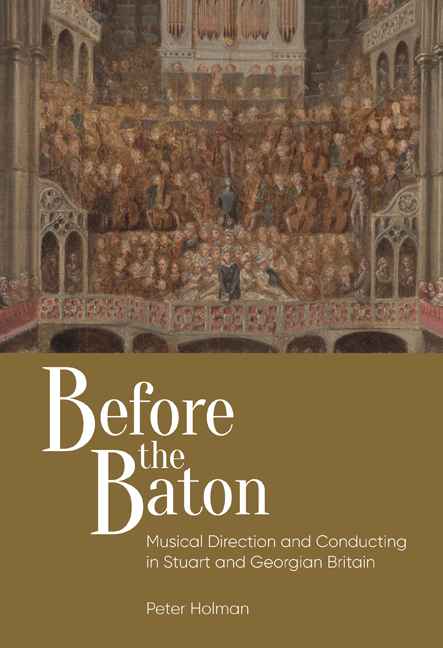Book contents
- Frontmatter
- Dedication
- Contents
- List of Illustrations
- Foreword
- Acknowledgements
- Note to the Reader
- List of Abbreviations
- Prelude To Beat or Not to Beat: The Continental Context
- Part I Directing Choral Music
- Chapter 1 ‘Heard but not Seen’: Leading Anglican Cathedral Music from the Organ
- Chapter 2 ‘With a Scroll of Parchment or Paper, in Hand’: Large- Scale Choral Music
- Chapter 3 ‘Accompanied all along on the Organ by his Own Inimitable Hand’: Handel and the Direction of his Oratorios
- Chapter 4 ‘The Conductor at the Organ’: The Oratorio Tradition after Handel
- Part II Directing Opera and Theatre Music
- Chapter 5 ‘That Ridiculous Custom’: From Devolved Direction to Centralized Time-Beating in Seventeenth-Century Theatre Music
- Chapter 6 ‘Il maestro al cembalo’: Directing Opera and Theatre Music from the Harpsichord
- Chapter 7 ‘A New Discipline and a New Style of Playing’: Directing Opera and Theatre Music from the Violin
- Chapter 8 ‘That Powerful Sovereign, the Conductor’: From the Piano to the Rostrum
- Postlude Superconductors or Semiconductors? Lessons for Today
- Bibliography
- Index
- Miscellaneous Endmatter
Chapter 5 - ‘That Ridiculous Custom’: From Devolved Direction to Centralized Time-Beating in Seventeenth-Century Theatre Music
Published online by Cambridge University Press: 11 September 2020
- Frontmatter
- Dedication
- Contents
- List of Illustrations
- Foreword
- Acknowledgements
- Note to the Reader
- List of Abbreviations
- Prelude To Beat or Not to Beat: The Continental Context
- Part I Directing Choral Music
- Chapter 1 ‘Heard but not Seen’: Leading Anglican Cathedral Music from the Organ
- Chapter 2 ‘With a Scroll of Parchment or Paper, in Hand’: Large- Scale Choral Music
- Chapter 3 ‘Accompanied all along on the Organ by his Own Inimitable Hand’: Handel and the Direction of his Oratorios
- Chapter 4 ‘The Conductor at the Organ’: The Oratorio Tradition after Handel
- Part II Directing Opera and Theatre Music
- Chapter 5 ‘That Ridiculous Custom’: From Devolved Direction to Centralized Time-Beating in Seventeenth-Century Theatre Music
- Chapter 6 ‘Il maestro al cembalo’: Directing Opera and Theatre Music from the Harpsichord
- Chapter 7 ‘A New Discipline and a New Style of Playing’: Directing Opera and Theatre Music from the Violin
- Chapter 8 ‘That Powerful Sovereign, the Conductor’: From the Piano to the Rostrum
- Postlude Superconductors or Semiconductors? Lessons for Today
- Bibliography
- Index
- Miscellaneous Endmatter
Summary
IN the preceding four chapters I have discussed the direction of choral music from seventeenth-century cathedrals to Victorian choral societies. We now return to the seventeenth century to investigate the ways music was directed in the English theatre, starting with the reign of James I. I should admit straight away that I cannot offer any startling new insights into the practice of Shakespeare's company, the King's Men, for the simple reason that it was a commercial enterprise and therefore its music was on a small scale. There were typically six instrumentalists in the music room of the indoor Blackfriars Theatre, apparently placed above the stage or in a gallery at the side. Vocal music seems mostly to have been performed onstage with singing actors accompanying themselves with lute-family instruments. Musical direction would doubtless have come from inside the instrumental ensemble, usually from the composer or composers of the songs and instrumental music for particular plays. For the King's Men this seems mostly to have been the court lutenist Robert Johnson (c.1583–1633), the main composer for the company from at least 1607 to 1623; he probably wrote all the vocal music required for The Tempest and The Winter's Tale.
Instead, the focus of the first part of this chapter will be on the court masque, that extravagant ancestor of the modern musical. Luckily for us, masques were glamorous and extremely well documented events, performed by large numbers of singers and instrumentalists. Their texts were usually printed to preserve their memory; spectators often wrote descriptions of them, including the secretaries of foreign ambassadors who had to write detailed descriptions of court life to send home; and the productions would have generated a mountain of paperwork in the court bureaucracy, some of which has survived. Masques have been studied intensively by theatre historians for more than a century, most recently in CEWBJO, the splendid new online edition of Ben Jonson – the most important author of Jacobean masque texts. We shall see that in the masque literature there is an almost total absence of evidence for the controlling hand of a single individual (and some evidence for its absence), though there is an exception that proves the rule: the poet, medical doctor and amateur composer Thomas Campion.
- Type
- Chapter
- Information
- Before the BatonMusical Direction and Conducting in Stuart and Georgian Britain, pp. 181 - 214Publisher: Boydell & BrewerPrint publication year: 2020



